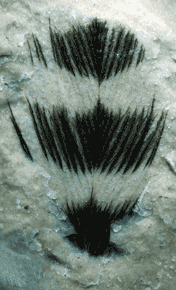
 |
||
The Yale Alumni Magazine is owned and operated by Yale Alumni Publications, Inc., a nonprofit corporation independent of Yale University. The content of the magazine and its website is the responsibility of the editors and does not necessarily reflect the views of Yale or its officers. |
|
When paleontology graduate student Jakob Vinther examined this 100-million-year-old fossil feather under a microscope, he expected to see tiny sausage-shaped objects that scientists had previously identified as fossil bacteria. He did, but he also recognized the objects—not as bacteria, but as melanosomes, the organelles in modern creatures that give rise to pigments.
Whereas bacteria would have been distributed evenly throughout the feather, Vinther’s research team confirmed that the objects exist only in the dark bands. The discovery, described in the July 9 issue of Biology Letters, has scientists excited about finally determining the colors of prehistoric birds and dinosaurs. In this fossil, the bands are black because the
melanosomes were preserved as carbon. Vinther identified them by shape as
eumelanosomes, which, as it happens, also produce black coloring in life.
Therefore, he says, the dinosaur that once wore this feather looked “more like
a woodpecker than a warbler.” |
|
|
|
|
|
|
|
|
©1992–2012, Yale Alumni Publications, Inc. All rights reserved. Yale Alumni Magazine, P.O. Box 1905, New Haven, CT 06509-1905, USA. yam@yale.edu |
||
